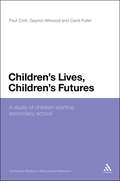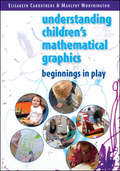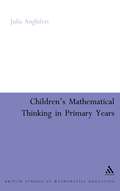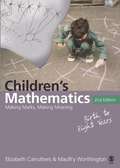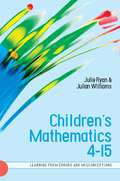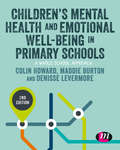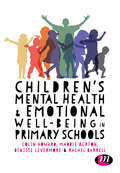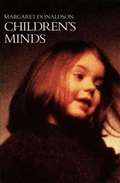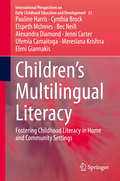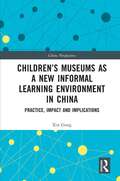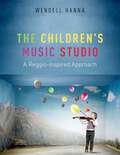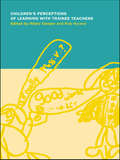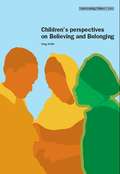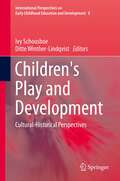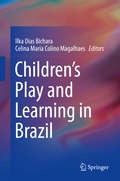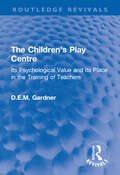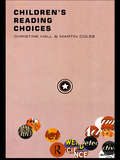- Table View
- List View
Children's Lives, Children's Futures: A Study of Children Starting Secondary School (Continuum Studies in Educational Research #42)
by Anthony Haynes Carol Fuller Gaynor Attwood Paul CrollIn many Western societies there is concern that children from less advantaged social backgrounds have limited aspirations, and are disproportionately unlikely to go to university. Children's Lives, Children's Futures explores how children in their first year of secondary school feel about school, its place in their lives and its role in their futures. The authors use child voice to look at the ways in which children are active constructors of their lives, and the implications this has for the alignment between education and ambition.The authors explore the nature of children's engagement with education, the choices and constraints they experience and the reasons some young people fail to take advantage of educational opportunities.
Children’s Mathematical Graphics: Beginnings In Play (UK Higher Education OUP Humanities & Social Sciences Education OUP)
by Elizabeth Carruthers Maulfry WorthingtonThis book challenges traditional beliefs and practices of teaching 'written' mathematics in early childhood. It gives theoretical underpinnings and offers exciting insights and context to children's early mathematical thinking and in particular into children's mathematical graphics, showing how this supports their understanding of the abstract symbolic language of mathematics. Drawing on a wide range of examples, it illustrates and explains how children explore and communicate their mathematical thinking through their mathematical graphics, and how this begins in play.The book looks at the power of children's own marks, symbols and other graphical representations to convey meanings, exploring how they support complex thinking. The authors explore the relationship between children's play and meaning making. Rather than viewing mathematics as a separate subject or as a set of basic 'skills' to be transmitted, they demonstrate that in supportive learning cultures children develop their own mathematical thinking to solve problems.Key features include:Numerous new examples and case studies of children from birth to 8 years,highlighting the complexity and richness of children's thinkingExplanation of pedagogical issues - showing how they can support rich play and mathematicsDraws on the authors' latest research This book is valuable reading for students, teachers, primary mathematics coordinators' and all early years' professionals working in the Early Years Foundation Stage and Key Stage One.
Children's Mathematical Thinking in Primary Years
by Julia AnghileriThis popular Continuum series, intended chiefly for teachers and trainee teachers, places strong emphasis on practice but at the same time incorporates the latest research in the field. The book demonstrates a strong belief in the ability of children to learn, and in the ability of teachers to increase children's learning potential.The series authors are distinguished practitioners in their fields who write with authority, but without jargon.With the increasingly popular constructivist framework for learning, teachers are coming to recognize the limitations of taught procedures and to find ways to encourage children to generate their own knowledge and understanding in mathematics. The challenge for teachers is to promote an environment that encourages mathematical thinking in which pupils of all abilities are able to achieve their full potential. This text brings together experiences of teachers and researchers who examine the ways children work mathematically, in order to provide an enhanced learning environment within the classroom. It also addresses key issues in current maths teaching.
Children's Mathematical Thinking in Primary Years: Perspectives On Children's Learning
by Julia AnghileriThis popular Continuum series, intended chiefly for teachers and trainee teachers, places strong emphasis on practice but at the same time incorporates the latest research in the field. The book demonstrates a strong belief in the ability of children to learn, and in the ability of teachers to increase children's learning potential.The series authors are distinguished practitioners in their fields who write with authority, but without jargon.With the increasingly popular constructivist framework for learning, teachers are coming to recognize the limitations of taught procedures and to find ways to encourage children to generate their own knowledge and understanding in mathematics. The challenge for teachers is to promote an environment that encourages mathematical thinking in which pupils of all abilities are able to achieve their full potential. This text brings together experiences of teachers and researchers who examine the ways children work mathematically, in order to provide an enhanced learning environment within the classroom. It also addresses key issues in current maths teaching.
Children's Mathematics: Making Marks, Making Meaning
by Maulfry Worthington Elizabeth CarruthersVisit the author's own website here! Children's Mathematics Network 'In Case Study 5 (a grassroots 'Children's Mathematics Network group') the initiative supported the participants in their professional change by giving them a space for the detailed and joint consideration of children's mathematical thinking. Another significant feature of this initiative is its focus on careful consideration and analysis of children's mathematics, and the ways in which professionals can support and encourage the children's mathematical thinking and reasoning… The standard of the mathematical understanding, thinking and reasoning that the displays revealed was far higher than the specified curriculum objectives for children of this age…' - Researching Effective CPD in Mathematics Education (RECME) project: (NCETM, 2009) 'The review also plays great score by play-based learning of a mathematical nature, and makes specific recommendations regarding early mark-making as a precursor to abstract mathematical symbolism'. Section 115 features children's mathematical graphics and emphasises: 'The role of mark-making in children's cognitive development is set out in the taxonomy (Carruthers and Worthington, 2006)'. The report recommends that 'local authorities, leaders, managers and head teachers should provide a culture with a significant focus on mathematical mark-making' and 'a learning environment that encourages children to choose to use their own mathematical graphics to support their mathematical thinking and processes' - The Williams Maths Review: (DCSF, 2008) `At the very heart of the success of the book is the authors' ability to see mathematics through young children's eyes by listening to and reflecting on the constant efforts made by children to make sense of their world. This is a liberating book which proposes that the teaching of mathematics could and should be a highly creative and enjoyable proceess' - Branwen Llewelyn Jones, Early Years Consultant at PACE Ltd / TACTYC 'Ground breaking... To single out any one chapter would be unfair because there is something thought-provoking and inspirational throughout. If you want to expand your understanding upwards and outwards then get a copy soon' - Times Educational Supplement 'I first read Children's Mathematics, Making Marks, Making Meaning a couple of years ago and it had an immediate impact on my own thinking and teaching, and the work I do with trainee teachers. I'm sure you will find it compelling reading too. I think it has the potential to change, in a fundamental way, how we think about early mathematical development' - Lynne McClure, Editor, Math Co-ordiator's File, Mathematics Association 'In their exceptionally readable and informative book, Children's Mathematics, Making Marks, Making Meaning Carruthers and Worthington (2006) draw attention to one of the main goals of early years teaching, that is, to help children make links between the mathematics they have already encountered (and continue to engage with) at home and the more abstract mathematics of the school. These authors suggest that by encouraging children to represent mathematical ideas in their own ways and, crucially, by talking to the pupils about the marks they have made, we are given a "window" onto their thinking that may otherwise be inaccessible' - Liz Pumphrey, NRICH This book draws on the authors' many years of teaching children aged three to eight years and also on their extensive research with children in the home, nursery and school. The authors explain the development and range of young children's mathematical marks and visual representations, showing how children make mental connections between their own early marks and subsequent abstract mathematical symbolism, and go on to develop their own written methods. Combining theory and practice, this acclaimed book demonstrates how children's own mathematical graphics are highly creative and show deep levels of thinking. The authors show how this is the key to success in school mathematics and to higher levels of achievement. The autho...
Children’s Mathematics 4-15: Learning From Errors And Misconceptions (UK Higher Education OUP Humanities & Social Sciences Education OUP)
by Julie Ryan Julian WilliamsThe mistakes children make in mathematics are usually not just ‘mistakes’ - they are often intelligent generalizations from previous learning. Following several decades of academic study of such mistakes, the phrase ‘errors and misconceptions’ has recently entered the vocabulary of mathematics teacher education and has become prominent in the curriculum for initial teacher education.The popular view of children’s errors and misconceptions is that they should be corrected as soon as possible. The authors contest this, perceiving them as potential windows into children’s mathematics. Errors may diagnose significant ways of thinking and stages in learning that highlight important opportunities for new learning.This book uses extensive, original data from the authors’ own research on children’s performance, errors and misconceptions across the mathematics curriculum. It progressively develops concepts for teachers to use in organizing their understanding and knowledge of children’s mathematics, offers practical guidance for classroom teaching and concludes with theoretical accounts of learning and teaching.Children’s Mathematics 4-15 is a groundbreaking book, which transforms research on diagnostic errors into knowledge for teaching, teacher education and research on teaching. It is essential reading for teachers, students on undergraduate teacher training courses and graduate and PGCE mathematics teacher trainees, as well as teacher educators and researchers.
Children’s Mental Health and Emotional Well-being in Primary Schools (Primary Teaching Now)
by Colin Howard Maddie Burton Denisse LevermoreMany teachers feel overwhelmed and lack confidence when it comes to dealing with mental health and emotional well-being of children these issues in their classrooms. This text supports schools and teachers to develop strategies to enhance the importance of mental health and emotional well-being, to work on preventative strategies and to support children when they need more intervention. The new edition of this important text is now updated to include coverage on the impact of early life experiences on children's mental health as well as more on the influence of technology and social media. This second edition also comes with a new 'critical thinking' feature that encourages students to reflect on these issues. It outlines lots of effective strategies for working with children who are struggling to manage the school day and offers advice for engaging meaningfully with parents. The final chapter 'Who's looking after who?' reminds the reader that schools should seek to support their staff, as well as their pupils.
Children’s Mental Health and Emotional Well-being in Primary Schools (Primary Teaching Now)
by Colin Howard Maddie Burton Denisse LevermoreMany teachers feel overwhelmed and lack confidence when it comes to dealing with mental health and emotional well-being of children these issues in their classrooms. This text supports schools and teachers to develop strategies to enhance the importance of mental health and emotional well-being, to work on preventative strategies and to support children when they need more intervention. The new edition of this important text is now updated to include coverage on the impact of early life experiences on children's mental health as well as more on the influence of technology and social media. This second edition also comes with a new 'critical thinking' feature that encourages students to reflect on these issues. It outlines lots of effective strategies for working with children who are struggling to manage the school day and offers advice for engaging meaningfully with parents. The final chapter 'Who's looking after who?' reminds the reader that schools should seek to support their staff, as well as their pupils.
Children’s Mental Health and Emotional Well-being in Primary Schools: A whole school approach
by Colin Howard Denisse Levermore Maddie Burton Rachel BarrellThe mental health and emotional wellbeing of children is fantastically important. It has a huge impact on learning and development and more and more, there is recognition of the importance of mental health for everyone. Despite this, many school staff feel overwhelmed and lack confidence when it comes to dealing with these issues in their classrooms. This new text is written for all those working in primary schools. It supports schools to develop strategies to enhance the importance of mental health and emotional wellbeing, to work on preventative strategies and to support children when they need more intervention. The text explores what we mean by mental health and wellbeing. Many children will not reach the threshold for clinical diagnosis, but they nonetheless need support. This text will outline lots of effective strategies for working with children who are struggling to manage the school day. It offers advice for engaging meaningfully with parents and considers the importance of working with school staff to ensure they are fully supported.
Children’s Mental Health and Emotional Well-being in Primary Schools: A whole school approach (PDF)
by Colin Howard Denisse Levermore Maddie Burton Rachel BarrellThe mental health and emotional wellbeing of children is fantastically important. It has a huge impact on learning and development and more and more, there is recognition of the importance of mental health for everyone. Despite this, many school staff feel overwhelmed and lack confidence when it comes to dealing with these issues in their classrooms. This new text is written for all those working in primary schools. It supports schools to develop strategies to enhance the importance of mental health and emotional wellbeing, to work on preventative strategies and to support children when they need more intervention. The text explores what we mean by mental health and wellbeing. Many children will not reach the threshold for clinical diagnosis, but they nonetheless need support. This text will outline lots of effective strategies for working with children who are struggling to manage the school day. It offers advice for engaging meaningfully with parents and considers the importance of working with school staff to ensure they are fully supported.
Children's Minds (PDF)
by Margaret DonaldsonMargaret Donaldson's seminal work on child development, first published in 1978, has become a classic inquiry into the nature of human thought. In this concise and brilliantly readable book, Margaret Donaldson shows that context is key when it comes to the development of language and thought, and how the right support can ensure children are skilled in these areas before they even start school. She revisits earlier theories of child development, notably those of Jean Piaget, to expose flaws in the accepted wisdom on child psychology and to suggest a range of new strategies to help children combat difficulties. As wise and perceptive today as it was when it first appeared, Margaret Donaldson#65533;#65533;e#65533;(tm)s bestselling work is essential reading for anyone interested in child development and child psychology.
Children’s Multilingual Literacy: Fostering Childhood Literacy in Home and Community Settings (International Perspectives on Early Childhood Education and Development #31)
by Pauline Harris Cynthia Brock Elspeth McInnes Bec Neill Alexandra Diamond Jenni Carter Ufemia Camaitoga Meresiana Krishna Eleni GiannakisThis book offers a comprehensive report on a three-year, cross-cultural, critical participatory action research study, conducted in children’s homes and communities in Fiji. This project contributed to building sustainable local capacity in communities without access to early childhood services, so as to promote preschool children’s literacy development in their home languages and English. The book includes rich descriptions of the young children’s lived, multilingual literacy practices in their home and community contexts. This work advances research-based practices for fostering young children’s multilingual literacy and building community capacity in a post-colonial Pasifika context; further, it shares valuable insights into processes and complexities that are inherent to multiliteracy and cross-cultural research.
Children’s Museums as a New Informal Learning Environment in China: Practice, Impact and Implications (China Perspectives)
by Xin GongBased on solid theoretical and empirical analyses, this book provides a first and fresh introduction to the recent development of children’s museums in China, along with their educational and social impacts as an informal learning environment for children, families, and society in general. To understand the benefits of children’s museums and in providing stimulating, informal education to children, the book looks into the origin and historical development of these institutions and how they have been influenced by informal learning theory, museum education, and early childhood education while providing case studies of children’s museums in China and the learning that takes place in them. This research analyses the process of informal learning and provides guidance on ways of elevating children’s cognitive and noncognitive development in the informal space. Different stakeholders of children's museums, including parents and educators, practitioners and designers, researchers of informal education, early childhood education, and policy makers will benefit from the insights provided in this book.
Children’s Museums as a New Informal Learning Environment in China: Practice, Impact and Implications (China Perspectives)
by Xin GongBased on solid theoretical and empirical analyses, this book provides a first and fresh introduction to the recent development of children’s museums in China, along with their educational and social impacts as an informal learning environment for children, families, and society in general. To understand the benefits of children’s museums and in providing stimulating, informal education to children, the book looks into the origin and historical development of these institutions and how they have been influenced by informal learning theory, museum education, and early childhood education while providing case studies of children’s museums in China and the learning that takes place in them. This research analyses the process of informal learning and provides guidance on ways of elevating children’s cognitive and noncognitive development in the informal space. Different stakeholders of children's museums, including parents and educators, practitioners and designers, researchers of informal education, early childhood education, and policy makers will benefit from the insights provided in this book.
The Children's Music Studio: A Reggio-inspired Approach
by Wendell HannaThe Children's Music Studio provides music teachers, parents and early childhood educators a wealth of materials and a clear roadmap for applying Reggio Emilia principles and practices to preschool and early childhood music education. Drawing on Professor Hanna's extensive experience researching and teaching in Reggio-inspired music classrooms, this pioneering book provides a comprehensive and in-depth manual for designing music ateliers-hands-on studios that capture the imagination and creativity of children. Informed by the cutting edge research on music learning, this practical guide includes detailed studio plans, examples of Reggio-inspired music studio explorations and documentation of children's work in music studios. In this book you will: - Discover how children can naturally learn music through the studio approach - See detailed examples and documentation of project-based studio learning - Understand how music learning increases overall artistic and academic literacy across the curriculum - Learn how to develop customized projects for your classroom that will teach children to think and communicate fluently through music and sound Early childhood and elementary music teachers will find this book especially useful as it provides innovative ideas for Reggio-inspired music teaching and learning techniques that can be integrated into the existing curriculum.
The Children's Music Studio: A Reggio-inspired Approach
by Wendell HannaThe Children's Music Studio provides music teachers, parents and early childhood educators a wealth of materials and a clear roadmap for applying Reggio Emilia principles and practices to preschool and early childhood music education. Drawing on Professor Hanna's extensive experience researching and teaching in Reggio-inspired music classrooms, this pioneering book provides a comprehensive and in-depth manual for designing music ateliers-hands-on studios that capture the imagination and creativity of children. Informed by the cutting edge research on music learning, this practical guide includes detailed studio plans, examples of Reggio-inspired music studio explorations and documentation of children's work in music studios. In this book you will: - Discover how children can naturally learn music through the studio approach - See detailed examples and documentation of project-based studio learning - Understand how music learning increases overall artistic and academic literacy across the curriculum - Learn how to develop customized projects for your classroom that will teach children to think and communicate fluently through music and sound Early childhood and elementary music teachers will find this book especially useful as it provides innovative ideas for Reggio-inspired music teaching and learning techniques that can be integrated into the existing curriculum.
Children's Perceptions of Learning with Trainee Teachers
by Hilary Cooper Rob HylandThis book is unique as it focuses on pupils' perceptions of their learning with trainee teachers in primary schools. It aims to raise trainee teachers' awareness of the importance of considering pupils' perceptions in evaluating their teaching and provides frameworks for doing so. It enables teachers to make links between theory, research and practice as part of their on-going development.The text includes:*interviews with primary pupils*examples of new teaching approaches*case studies offering pupil insights into curriculum subjects*chapter summaries giving suggestions for teaching strategies, discussions with mentors and tutors and further reading
Children's Perceptions of Learning with Trainee Teachers
by Hilary Cooper Rob HylandThis book is unique as it focuses on pupils' perceptions of their learning with trainee teachers in primary schools. It aims to raise trainee teachers' awareness of the importance of considering pupils' perceptions in evaluating their teaching and provides frameworks for doing so. It enables teachers to make links between theory, research and practice as part of their on-going development.The text includes:*interviews with primary pupils*examples of new teaching approaches*case studies offering pupil insights into curriculum subjects*chapter summaries giving suggestions for teaching strategies, discussions with mentors and tutors and further reading
Children's Perspectives on Believing and Belonging (PDF)
by Greg SmithBased on a study of over 100 9- to 11-year-old pupils from schools in deprived inner city areas in London and the North of England, this book explores children's views of religiously diverse schools and local communities. It shows that children's religious identities and experiences are diverse and complex, that they understand many aspects of religious diversity, and that they are able to talk about it with interest and insight. It provides fascinating insights for professionals working in diverse school settings, as well as those who have an interest in policy debates on social cohesion, faith-based schools and faith communities.
Children's Play and Development: Cultural-Historical Perspectives (International Perspectives on Early Childhood Education and Development #8)
by Ivy Schousboe and Ditte Winther-LindqvistThis book provides new theoretical insights to our understanding of play as a cultural activity. All chapters address play and playful activities from a cultural-historical theoretical approach by re-addressing central claims and concepts in the theory and providing new models and understandings of the phenomenon of play within the framework of cultural historical theory. Empirical studies cover a wide range of institutional settings: preschool, school, home, leisure time, and in various social relations (with peers, professionals and parents) in different parts of the world (Europe, Australia, South America and North America). Common to all chapters is a goal of throwing new light on the phenomenon of playing within a theoretical framework of cultural-historical theory. Play as a cultural, collective, social, personal, pedagogical and contextual activity is addressed with reference to central concepts in relation to development and learning. Concepts and phenomena related to ZPD, the imaginary situation, rules, language play, collective imagining, spheres of realities of play, virtual realities, social identity and pedagogical environments are presented and discussed in order to bring the cultural-historical theoretical approach into play with contemporary historical issues. Essential as a must read to any scholar and student engaged with understanding play in relation to human development, cultural historical theory and early childhood education.
Children's Play and Learning in Brazil
by Ilka Dias Bichara Celina Maria MagalhaesThis book presents for the first time in English language an overview of the research done in Brazil in the field of studies of children’s play. The volume brings together contributions from researchers of the Working Group Toy, Education and Health, of the Brazilian National Association of Research and Graduate Studies in Psychology (ANPEPP), including empirical studies and literature reviews about indigenous children, riverside communities, urban children in situation of social vulnerability, projects of early childhood education and the ludic possibilities of digital technologies. It aims to show the cultural diversity of Brazil expressed in its children’s play, providing valuable resources for international researchers of play interested in intercultural studies.
The Children's Play Centre: Its Psychological Value and its Place in the Training of Teachers (Routledge Revivals)
by D.E.M. GardnerFirst published in 1937, The Children’s Play Centre is an account of Gardner’s Play Centre and her work in assessing its value in the education of children and the training of teachers. The book puts forward the value of play in the development of children and provides a detailed report of Gardner’s experiment. It also explores the significance of the Play Centre to the technique of training students. It will have lasting relevance for those interested in the history of education and the psychology of education.
The Children's Play Centre: Its Psychological Value and its Place in the Training of Teachers (Routledge Revivals)
by D.E.M. GardnerFirst published in 1937, The Children’s Play Centre is an account of Gardner’s Play Centre and her work in assessing its value in the education of children and the training of teachers. The book puts forward the value of play in the development of children and provides a detailed report of Gardner’s experiment. It also explores the significance of the Play Centre to the technique of training students. It will have lasting relevance for those interested in the history of education and the psychology of education.
Children's Reading Choices
by Martin Coles Christine HallChildren's Reading Choices discusses the reading habits of children aged between 10 and 14. The book reports the findings of the Children's Reading Choices project - conducted by the authors from the University of Nottingham and the largest national survey of children's reading choices since the 1970s. The book includes reports and discussion on: * girls' and boys' reading preferences and the differences between their reading habits * the place of series books, teenage magazines and comics in children's reading * the most popular authors and titles at different ages * purchasing habits and library use.
Children's Reading Choices
by Martin Coles Christine HallChildren's Reading Choices discusses the reading habits of children aged between 10 and 14. The book reports the findings of the Children's Reading Choices project - conducted by the authors from the University of Nottingham and the largest national survey of children's reading choices since the 1970s. The book includes reports and discussion on: * girls' and boys' reading preferences and the differences between their reading habits * the place of series books, teenage magazines and comics in children's reading * the most popular authors and titles at different ages * purchasing habits and library use.
